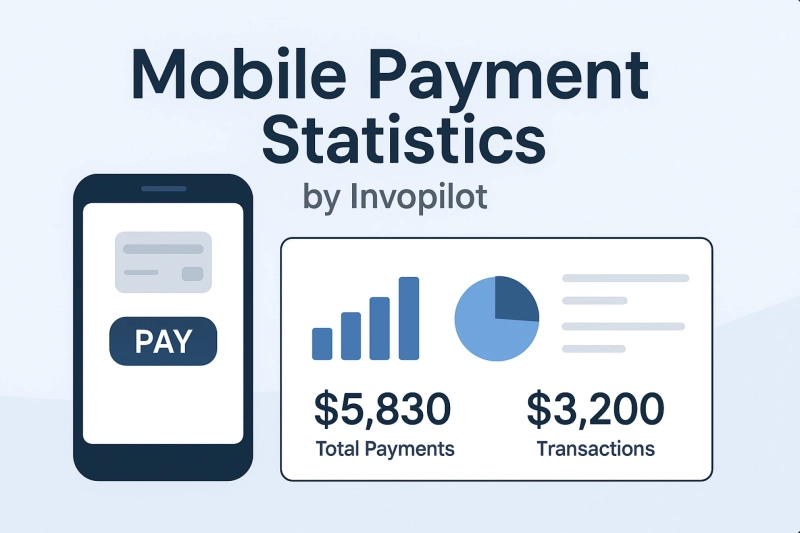
Mobile payments have become a driving force behind the evolution of how consumers and businesses handle transactions. With technology advancing rapidly and convenience becoming a critical factor for users, mobile payments are reshaping payment landscapes across the globe. This article dives into the growth, trends, and key mobile payment statistics, highlighting their adoption rate and the impact on businesses.
The Rise of Mobile Payments
The global growth of mobile payment systems is nothing short of remarkable. According to recent data, the mobile payment market is expected to surpass $12 trillion by 2027, fueled by widespread smartphone adoption and improved internet accessibility. With a staggering number of users worldwide relying on their devices for daily activities, payments via mobile apps and wallets offer unparalleled convenience.
Key Statistics
- Over 3.5 billion people globally use smartphones, creating a massive potential market for mobile payment solutions.
- 60% of all e-commerce transactions now happen on mobile devices.
- By 2025, it’s estimated that 50% of all payments made globally will be done through mobile wallets such as Apple Pay, Google Pay, and Samsung Pay.
What’s driving these changes? The answer lies in user expectations. People want a seamless, secure, and quick way to pay. Mobile payments provide just that, often eliminating the need for traditional cash or card-based transactions.
Trends in Mobile Payments
Understanding trends helps businesses stay ahead in a competitive market. Here are some of the most notable shifts in the mobile payment ecosystem:
1. Contactless Payments Are Thriving
Contactless payments surged during the pandemic as people became more cautious about physical contact. This trend continues, with data showing that contactless payments will grow by 22% annually over the next five years. Enabled by technologies like NFC (Near-Field Communication), this method is particularly popular in retail, restaurants, and public transportation.
2. QR Code Payments
QR code-based systems are seeing massive growth, especially in regions like Asia-Pacific. Countries such as China and India have pioneered this payment method, with apps like Alipay and Paytm allowing users to scan codes to make payments instantly. A forecast by GlobalData shows QR-based payments expected to grow at a compound annual growth rate (CAGR) of 15% globally through 2030.
3. Rising Merchant Adoption
Small and medium businesses (SMBs) have started adopting mobile payment solutions due to their simplicity and lower operational costs. Digital invoicing platforms, for instance, integrate seamlessly with mobile payment systems to process transactions efficiently. If you’re looking to streamline your own payment processes, platforms like Invopilot offer tools to simplify invoicing and business workflow.
4. Mobile Payment Apps Specific to Gen Z and Millennials
Younger generations are leading the shift toward mobile-first banking and payments. Apps like Venmo, CashApp, and Zelle used predominantly by Millennials and Gen Z, make it easy to transfer money among peers or pay for services in seconds. The demographic heavily favors these options due to transparency and an easy user experience.
5. Global Expansion of E-Wallets
E-wallets are no longer limited to local markets. Players like PayPal, WeChat Pay, and Alipay are extending their services to international customers, enabling cross-border payments. Businesses tapping into this global network get access to millions of potential customers with minimal effort.
Benefits of Mobile Payments for Businesses
Mobile payments aren’t just convenient for customers; they also bring significant advantages for businesses looking to optimize their operations and scale their reach.
1. Improved Cash Flow
Mobile payments help businesses process transactions faster than traditional methods. For example, paired with tools like the invoice generator, companies can create professional invoices that allow for quick and hassle-free payment options. Faster payments mean healthier, more predictable cash flow for companies.
2. Enhanced Customer Experience
Offering mobile payment options adds convenience for consumers. Shoppers appreciate having quick checkout processes, whether in-store or online. Businesses that offer mobile-friendly solutions are more likely to retain customers and drive repeat purchases.
3. Lower Operational Costs
Mobile payments reduce the overhead costs associated with handling cash and maintaining point-of-sale hardware. Systems that accept e-wallet payments or QR code scans are easy to implement and often carry lower transaction fees, benefiting SMBs significantly.
4. Access to Data Insights
Mobile payments generate valuable data on customer behavior, which is vital for businesses looking to improve their strategies. For example, companies can analyze purchasing trends, popular transaction methods, and even regional preferences to tailor their services more effectively.
5. Enables Global Reach
With cross-border mobile payment solutions, businesses can enter international markets more efficiently. Whether it’s dealing with tourists or expanding e-commerce operations overseas, mobile payment compatibility ensures smoother transactions across the globe.
The Future of Mobile Payments
The future of mobile payments is not just digital but also embedded. We’re entering an age where everything from wearable devices to smart appliances can facilitate payments. Already, smartwatch payments have grown by 25% in the past year, and innovations in IoT (Internet-of-Things) hint at even more exciting possibilities.
Additionally, cryptocurrencies are emerging as a potential mobile payment method, combining decentralization with the convenience of app-based transactions. Early adopters may gain a competitive edge as the market evolves.
The integration of AI into payment platforms will further optimize fraud detection, offer personalized recommendations, and enhance overall security. Businesses that onboard such technologies can expect improved trust in their systems and an increase in customer base.
Closing Thoughts
The rapid rise of mobile payments is a clear indicator of where technology and convenience intersect. Understanding the current statistics and trends allows businesses to make informed decisions about adopting and optimizing these solutions. Whether you’re an SMB or a large corporation, ensuring that your payment options cater to mobile users can significantly impact your customer retention and profitability.
With so many advancements already transforming the industry, now is the perfect time to explore tools that enhance your operational efficiency. Platforms like Invopilot, equipped with invoice-generation features, can simplify workflows, ensuring your business keeps pace with the increasingly digital payment landscape.


